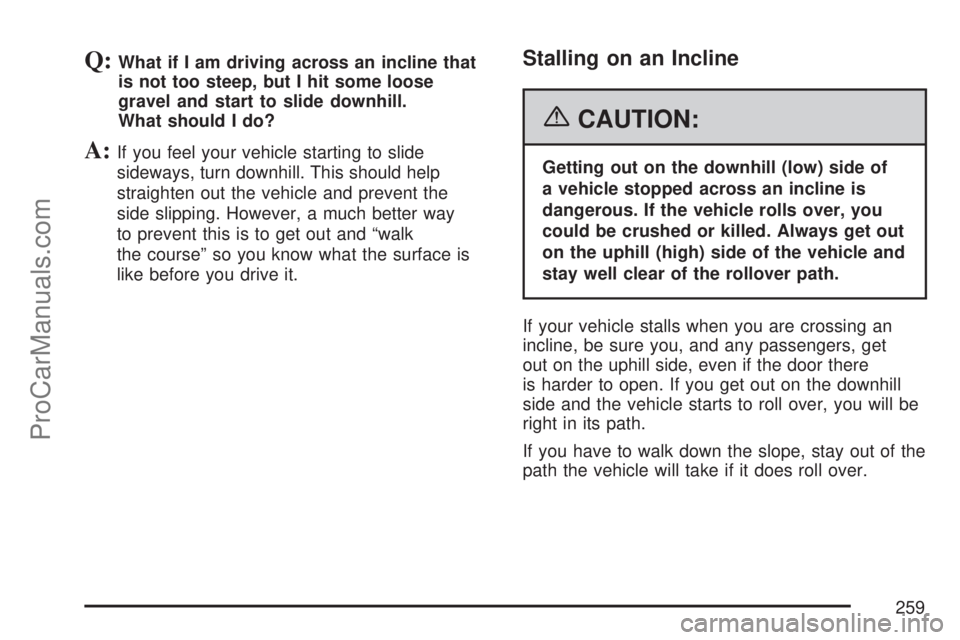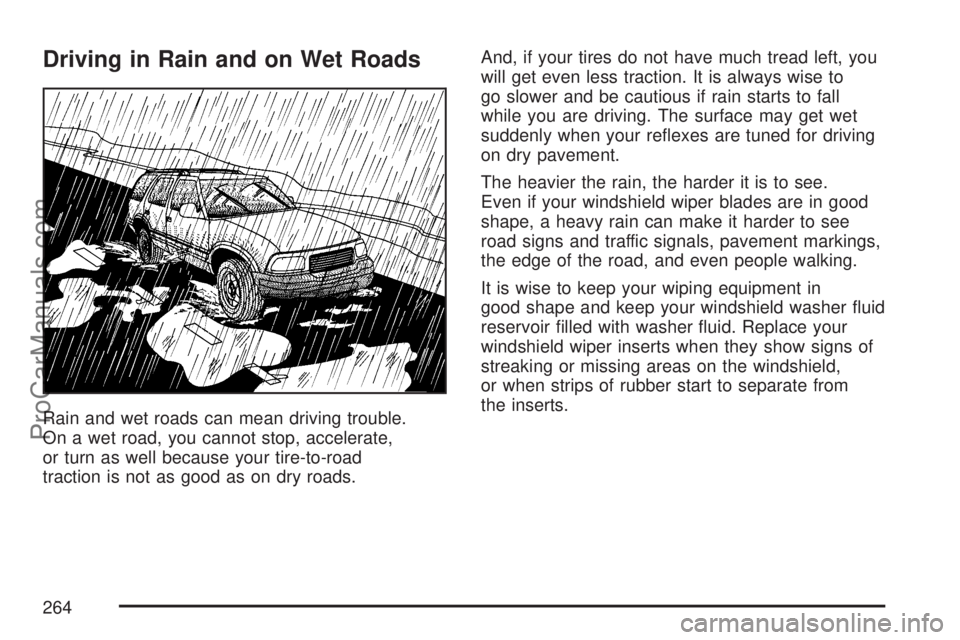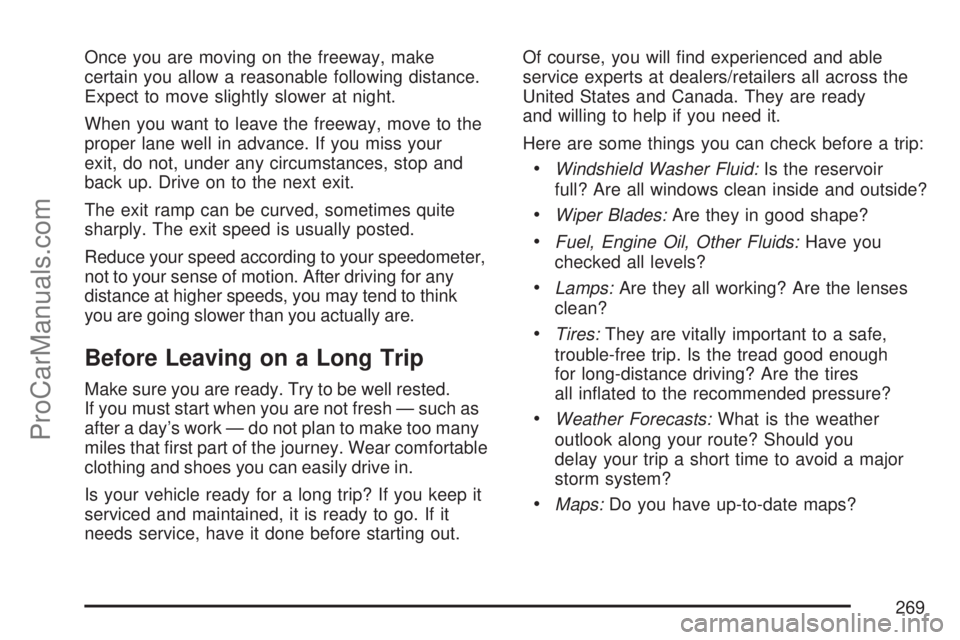stop start SATURN VUE 2007 Owner's Manual
[x] Cancel search | Manufacturer: SATURN, Model Year: 2007, Model line: VUE, Model: SATURN VUE 2007Pages: 470, PDF Size: 3.1 MB
Page 251 of 470

Scanning the Terrain
Off-road driving can take you over many different
kinds of terrain. You need to be familiar with
the terrain and its many different features.
Here are some things to consider.
Surface Conditions:Off-roading can take you
over hard-packed dirt, gravel, rocks, grass, sand,
mud, snow, or ice. Each of these surfaces affects
the steering, acceleration, and braking of your
vehicle in different ways. Depending upon the kind
of surface you are on, you may experience slipping,
sliding, wheel spinning, delayed acceleration, poor
traction, and longer braking distances.Surface Obstacles:Unseen or hidden obstacles
can be hazardous. A rock, log, hole, rut, or
bump can startle you if you are not prepared
for them. Often these obstacles are hidden by
grass, bushes, snow, or even the rise and fall of
the terrain itself. Here are some things to consider:
Is the path ahead clear?
Will the surface texture change abruptly
up ahead?
Does the travel take you uphill or downhill?
There is more discussion of these subjects
later.
Will you have to stop suddenly or change
direction quickly?
When you drive over obstacles or rough terrain,
keep a �rm grip on the steering wheel. Ruts,
troughs, or other surface features can jerk
the wheel out of your hands if you are not
prepared.
251
ProCarManuals.com
Page 255 of 470

Q:What should I do if my vehicle stalls, or is
about to stall, and I cannot make it up
the hill?
A:If this happens, there are some things you
should do, and there are some things you must
not do. First, here is what youshoulddo:
Push the brake pedal to stop the vehicle and
keep it from rolling backwards. Also, apply the
parking brake.
If the engine is still running, shift the transaxle
to REVERSE (R), release the parking brake,
and slowly back down the hill in REVERSE (R).
If the engine has stopped running, you will
need to restart it. With the brake pedal pressed
and the parking brake still applied, shift the
transaxle to PARK (P), or shift to NEUTRAL if
you have a manual transaxle, and restart the
engine. Then shift to REVERSE (R), release
the parking brake, and slowly back down the
hill as straight as possible in REVERSE (R).
As you are backing down the hill, put your left
hand on the steering wheel at the 12 o’clock
position. This way you will be able to tell if the
wheels are straight and maneuver as you back
down. It is best that you back down the hill with
the wheels straight rather than in the left or right
direction. Turning the wheel too far to the left or
right will increase the possibility of a rollover.
Here are some things youmust notdo if you stall,
or are about to stall, when going up a hill.
Never attempt to prevent a stall by shifting into
NEUTRAL (N), or pressing the clutch if you
have a manual transaxle, to rev-up the engine
and regain forward momentum. This will not
work. Your vehicle will roll backwards very
quickly and you could go out of control.
Instead, apply the regular brake to stop the
vehicle. Then apply the parking brake. Shift to
REVERSE (R), release the parking brake, and
slowly back straight down.
Never attempt to turn around if you are about to
stall when going up a hill. If the hill is steep
enough to stall your vehicle, it is steep enough
to cause it to roll over if you turn around. If you
cannot make it up the hill you must back
straight down the hill.
255
ProCarManuals.com
Page 257 of 470

Q:Are there some things I should not do
when driving down a hill?
A:Yes! These are important because if you
ignore them you could lose control and
have a serious accident.
When driving downhill, avoid turns that take
you across the incline of the hill. A hill that
is not too steep to drive down may be
too steep to drive across. Your vehicle could
roll over if you do not drive straight down.
Never go downhill with the transaxle in
NEUTRAL (N). This is called “free wheeling.”
The brakes will have to do all the work
and could overheat and fade.
Unless your vehicle has anti-lock brakes, avoid
braking so hard that you lock the wheels when
going downhill. If the wheels are locked, you
cannot steer your vehicle. If the wheels lock up
during downhill braking, you may feel the
vehicle starting to slide sideways. To regain
your direction, just ease off the brakes and
steer to keep the front of the vehicle pointing
straight downhill.
Q:Am I likely to stall when going downhill?
A:It is much more likely to happen going
uphill. But if it happens going downhill,
here is what to do.
1. Stop your vehicle by applying the regular
brakes. Apply the parking brake.
2. Shift to PARK (P), or NEUTRAL if you have
a manual transaxle, and, while still braking,
restart the engine.
3. Shift back to a low gear, release the parking
brake, and drive straight down.
4. If the engine will not start, get out and
get help.
257
ProCarManuals.com
Page 259 of 470

Q:What if I am driving across an incline that
is not too steep, but I hit some loose
gravel and start to slide downhill.
What should I do?
A:If you feel your vehicle starting to slide
sideways, turn downhill. This should help
straighten out the vehicle and prevent the
side slipping. However, a much better way
to prevent this is to get out and “walk
the course” so you know what the surface is
like before you drive it.
Stalling on an Incline
{CAUTION:
Getting out on the downhill (low) side of
a vehicle stopped across an incline is
dangerous. If the vehicle rolls over, you
could be crushed or killed. Always get out
on the uphill (high) side of the vehicle and
stay well clear of the rollover path.
If your vehicle stalls when you are crossing an
incline, be sure you, and any passengers, get
out on the uphill side, even if the door there
is harder to open. If you get out on the downhill
side and the vehicle starts to roll over, you will be
right in its path.
If you have to walk down the slope, stay out of the
path the vehicle will take if it does roll over.
259
ProCarManuals.com
Page 261 of 470

Driving in Water
{CAUTION:
Driving through rushing water can be
dangerous. Deep water can sweep your
vehicle downstream and you and your
passengers could drown. If it is only
shallow water, it can still wash away the
ground from under your tires, and you
could lose traction and roll the vehicle
over. Do not drive through rushing water.
Heavy rain can mean �ash �ooding, and �ood
waters demand extreme caution.Find out how deep the water is before you drive
through it. If it is deep enough to cover the
wheel hubs, axles, or exhaust pipe, do not
try it — you probably will not get through.
Also, water that deep can damage the axle
and other vehicle parts.
If the water is not too deep, drive slowly through it.
At faster speeds, water splashes on the ignition
system and your vehicle can stall. Stalling can also
occur if you get the tailpipe under water. And,
as long as the tailpipe is under water, you will
never be able to start the engine. When you go
through water, remember that when the brakes get
wet, it may take you longer to stop.
SeeDriving in Rain and on Wet Roads on
page 264for more information on driving
through water.
261
ProCarManuals.com
Page 264 of 470

Driving in Rain and on Wet Roads
Rain and wet roads can mean driving trouble.
On a wet road, you cannot stop, accelerate,
or turn as well because your tire-to-road
traction is not as good as on dry roads.And, if your tires do not have much tread left, you
will get even less traction. It is always wise to
go slower and be cautious if rain starts to fall
while you are driving. The surface may get wet
suddenly when your re�exes are tuned for driving
on dry pavement.
The heavier the rain, the harder it is to see.
Even if your windshield wiper blades are in good
shape, a heavy rain can make it harder to see
road signs and traffic signals, pavement markings,
the edge of the road, and even people walking.
It is wise to keep your wiping equipment in
good shape and keep your windshield washer �uid
reservoir �lled with washer �uid. Replace your
windshield wiper inserts when they show signs of
streaking or missing areas on the windshield,
or when strips of rubber start to separate from
the inserts.
264
ProCarManuals.com
Page 269 of 470

Once you are moving on the freeway, make
certain you allow a reasonable following distance.
Expect to move slightly slower at night.
When you want to leave the freeway, move to the
proper lane well in advance. If you miss your
exit, do not, under any circumstances, stop and
back up. Drive on to the next exit.
The exit ramp can be curved, sometimes quite
sharply. The exit speed is usually posted.
Reduce your speed according to your speedometer,
not to your sense of motion. After driving for any
distance at higher speeds, you may tend to think
you are going slower than you actually are.
Before Leaving on a Long Trip
Make sure you are ready. Try to be well rested.
If you must start when you are not fresh — such as
after a day’s work — do not plan to make too many
miles that �rst part of the journey. Wear comfortable
clothing and shoes you can easily drive in.
Is your vehicle ready for a long trip? If you keep it
serviced and maintained, it is ready to go. If it
needs service, have it done before starting out.Of course, you will �nd experienced and able
service experts at dealers/retailers all across the
United States and Canada. They are ready
and willing to help if you need it.
Here are some things you can check before a trip:
Windshield Washer Fluid:Is the reservoir
full? Are all windows clean inside and outside?
Wiper Blades:Are they in good shape?
Fuel, Engine Oil, Other Fluids:Have you
checked all levels?
Lamps:Are they all working? Are the lenses
clean?
Tires:They are vitally important to a safe,
trouble-free trip. Is the tread good enough
for long-distance driving? Are the tires
all in�ated to the recommended pressure?
Weather Forecasts:What is the weather
outlook along your route? Should you
delay your trip a short time to avoid a major
storm system?
Maps:Do you have up-to-date maps?
269
ProCarManuals.com
Page 298 of 470

Thus, you may think drivers behind you are seeing
your signal when they are not. It’s important to
check occasionally to be sure the trailer bulbs are
still working.
Driving on Grades
Notice:Do not tow on steep continuous
grades exceeding 6 miles (9.6 km). Extended,
higher than normal engine and transmission
temperatures may result and damage your
vehicle. Frequent stops are very important to
allow the engine and transmission to cool.
Reduce speed and shift to a lower gear before you
start down a long or steep downgrade. If you
don’t shift down, you might have to use your
brakes so much that they would get hot and no
longer work well.
On a long uphill grade, shift down and reduce
your speed to around 45 mph (70 km/h) to reduce
the possibility of the engine and the transmission
overheating. If your engine does overheat,
seeEngine Overheating on page 334.
Parking on Hills
{CAUTION:
You really should not park your vehicle,
with a trailer attached, on a hill.
If something goes wrong, your rig could
start to move. People can be injured, and
both your vehicle and the trailer can be
damaged.
But if you ever have to park your rig on a hill,
here’s how to do it:
1. Apply your regular brakes, but don’t shift into
PARK (P) for an automatic transmission, or
into gear for a manual transmission.
When parking uphill, turn your wheels away
from the curb. When parking downhill,
turn your wheels into the curb.
2. Have someone place chocks behind the
trailer wheels.
298
ProCarManuals.com
Page 299 of 470

3. When the chocks are in place, release the
regular brakes until the chocks absorb
the load.
4. Reapply the regular brakes. Then apply your
parking brake and shift into PARK (P) for an
automatic transmission or REVERSE (R) for
a manual transmission.
5. Release the regular brakes.
When You Are Ready to Leave After
Parking on a Hill
1. Apply your regular brakes and hold the pedal
down while you:
start your engine,
shift into a gear, and
release the parking brake.
2. Let up on the brake pedal.
3. Drive slowly until the trailer is clear of the
chocks.
4. Stop and have someone pick up and store
the chocks.
Maintenance When Trailer Towing
Your vehicle will need service more often when
you’re pulling a trailer. SeeScheduled Maintenance
on page 420for more information. Things that
are especially important in trailer operation are
automatic transmission �uid (don’t over�ll), engine
oil, axle lubricant, drive belt, cooling system and
brake system. Each of these is covered in this
manual, and the Index will help you �nd them
quickly. If you’re trailering, it’s a good idea to
review this information before you start your trip.
Check periodically to see that all hitch nuts and
bolts are tight.
Engine Cooling When Trailer Towing
Your cooling system may temporarily overheat
during severe operating conditions. SeeEngine
Overheating on page 334.
Changing a Tire When Trailer Towing
If you get a �at tire while towing a trailer, be
sure to secure the trailer and disconnect it from
the vehicle before changing the tire.
299
ProCarManuals.com
Page 301 of 470

Service........................................................ 304
Accessories and Modi�cations................... 304
California Proposition 65 Warning.............. 305
Doing Your Own Service Work.................. 305
Adding Equipment to the Outside of
Your Vehicle.......................................... 306
Fuel............................................................. 306
Gasoline Octane........................................ 306
Gasoline Speci�cations.............................. 306
California Fuel........................................... 307
Additives................................................... 307
Fuels in Foreign Countries........................ 308
Filling the Tank......................................... 309
Filling a Portable Fuel Container............... 311
Checking Things Under the Hood.............. 312
Hood Release........................................... 313
Engine Compartment Overview.................. 314
Engine Oil................................................. 318
Engine Oil Life System.............................. 323
Engine Air Cleaner/Filter............................ 324
Automatic Transaxle Fluid
(2.2L L4 Engine).................................... 327Automatic Transaxle Fluid
(3.5L V6 Engine).................................... 328
Manual Transaxle Fluid............................. 330
Hydraulic Clutch........................................ 331
Engine Coolant.......................................... 331
Coolant Surge Tank Pressure Cap............ 334
Engine Overheating................................... 334
Cooling System......................................... 336
Windshield Washer Fluid........................... 341
Brakes...................................................... 343
Battery...................................................... 347
Jump Starting............................................ 348
All-Wheel Drive........................................... 353
Headlamp Aiming........................................ 355
Bulb Replacement....................................... 358
Halogen Bulbs........................................... 358
Headlamps................................................ 358
Front Turn Signal and Parking Lamps....... 361
Center High-Mounted Stoplamp (CHMSL) ... 362
Taillamps, Turn Signal, Stoplamps and
Back-up Lamps...................................... 363
License Plate Lamp................................... 364
Replacement Bulbs................................... 364
Section 5 Service and Appearance Care
301
ProCarManuals.com